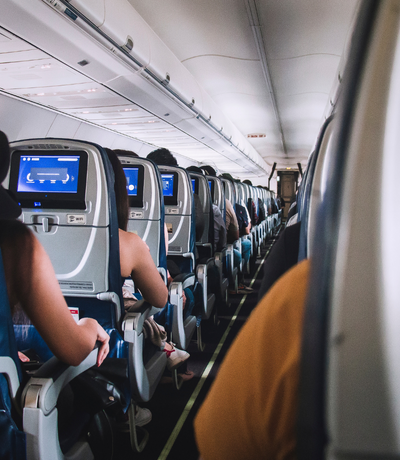How to Make Economy Class feel like Business
4 November 2022
When it comes to being comfortable on a flight, these factors are in play with regards to airline seats:
- Seat pitch (how much space between yours and the one in front)
- Legroom (how many inches your legs have to spread out)
- Seat width
To complicate things further, there used to be just three classes:
- First class – most expensive, nicest
- Business class – slightly less expensive, pretty nice
- Economy class – cheapest, and you get what you get
Frequent fliers who are accustomed to upgrades also know how to secure the best seat in coach. Here are their pro tips for scoring a seat in the main cabin and still feeling comfortable.

Spring for the comfort tax
In the never-ending quest to gain profits, airlines have figured out how to divide up an entire class of seats. Economy class isn’t just plain old economy anymore, it’s divided into premium economy and economy plus before you get to regular economy.
Confused yet? We don’t blame you. It’s complicated.
Premium economy
As you move down the aisle from the cockpit to the back of the plane, premium economy is just past the business class seats. A seat in premium economy is more expensive than regular old economy (as high as double the price) but still typically 65% less than business class.
On average, premium economy offers 5-7 inches more legroom and more space to recline.
Often in premium economy, passengers don’t have to pay fees on checked bags. They may also accrue miles at a different rate than a regular coach ticket.
Economy plus
Just past the premium economy seats is economy plus. It’s more affordable and part of the main class cabin, but there’s typically slightly more legroom than basic economy.
Many airlines offer economy plus tickets and brand it something else just to make things difficult.
- JetBlue calls it Even More Space and guarantees 7 inches extra legroom
- American Airlines calls it Main Cabin Extra and charges $20 for the seat
- On United, it’s called economy plus and you can even buy a subscription for this type of seat
- Delta calls it Comfort+ and you get the same amenity kit as first class
Honestly though, by the time you read and share this newsletter, the airlines will have figured out how to scramble up the benefits. And that takes us to our next tip.
Learn about the airline seat classes
There are several ways you can learn what each airline offers for the different seat classes, starting with the airline’s website.
Read up on the various classes so you’re informed before you book.
Get really curious about the differences because the decisions that come with choosing the right seat can be fairly overwhelming.
Check the seat width
Let’s start a little thanks for the babies. FAA regulations mandate that airplane seats have to be wide enough, at a minimum, to accommodate a child restraint system. A child restraint system used on an airplane may measure up to 16 inches wide, so that’s the minimum size.
Consider thinking about that the next time you’re sitting near an upset crying baby. Maybe it will help.
Currently, all US airlines go beyond that federal minimum, but not by much:
- Southwest Airlines 17.5 inches
- JetBlue Airways 18 inches
- Spirit Airlines 17.75 inches
- Breeze, Delta Air Lines, and Hawaiian Airlines 17.6
- Alaska Airlines, Allegiant, American Airlines, Avelo, and United Airlines 17 inches
Examine the legroom
The legroom in economy class seems to shrink as airlines add newer, more efficient, and tighter aircraft to their fleets.
The US airlines with the most legroom are as follows:
- JetBlue Airways and Southwest Airlines 32 inches
- Alaska Airlines and Hawaiian Airlines 31-32
- Delta Air Lines 30-32 inches
- American Airlines, Silver Airways, and United Airlines 31 inches
- Avelo Airlines and Breeze Airways 30 inches
Lots of travelers like to book the emergency row simply for the extra legroom. There are also some requirements for sitting in the exit row: at least 15 years of age and sufficient mobility in both arms, hands, and legs.
Some airlines charge extra to sit in the exit row, so booking early helps.
And finally
Ultimately, it comes down to picking the best seat for you. Boredom and stuck-ness are the enemy when flying economy, so do your best to decompress and get comfortable.
- Have plenty of well charged devices loaded with entertainment
- Invest in noise-canceling headphones
- Cocoon-up with eye mask, headphones, and blanket and sleep through it
Related topics
Damian Tysdal is the founder of CoverTrip, and is a licensed agent for travel insurance (MA 1883287). He believes travel insurance should be easier to understand, and started the first travel insurance blog in 2006.
